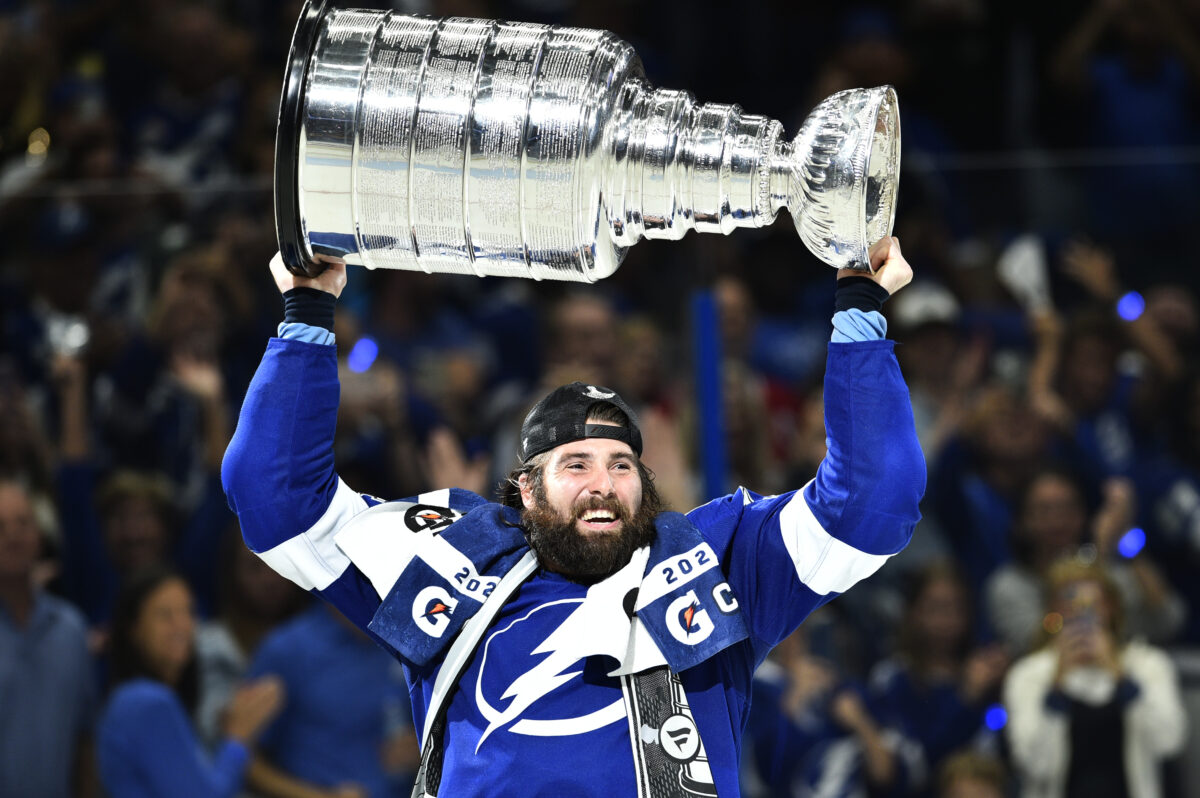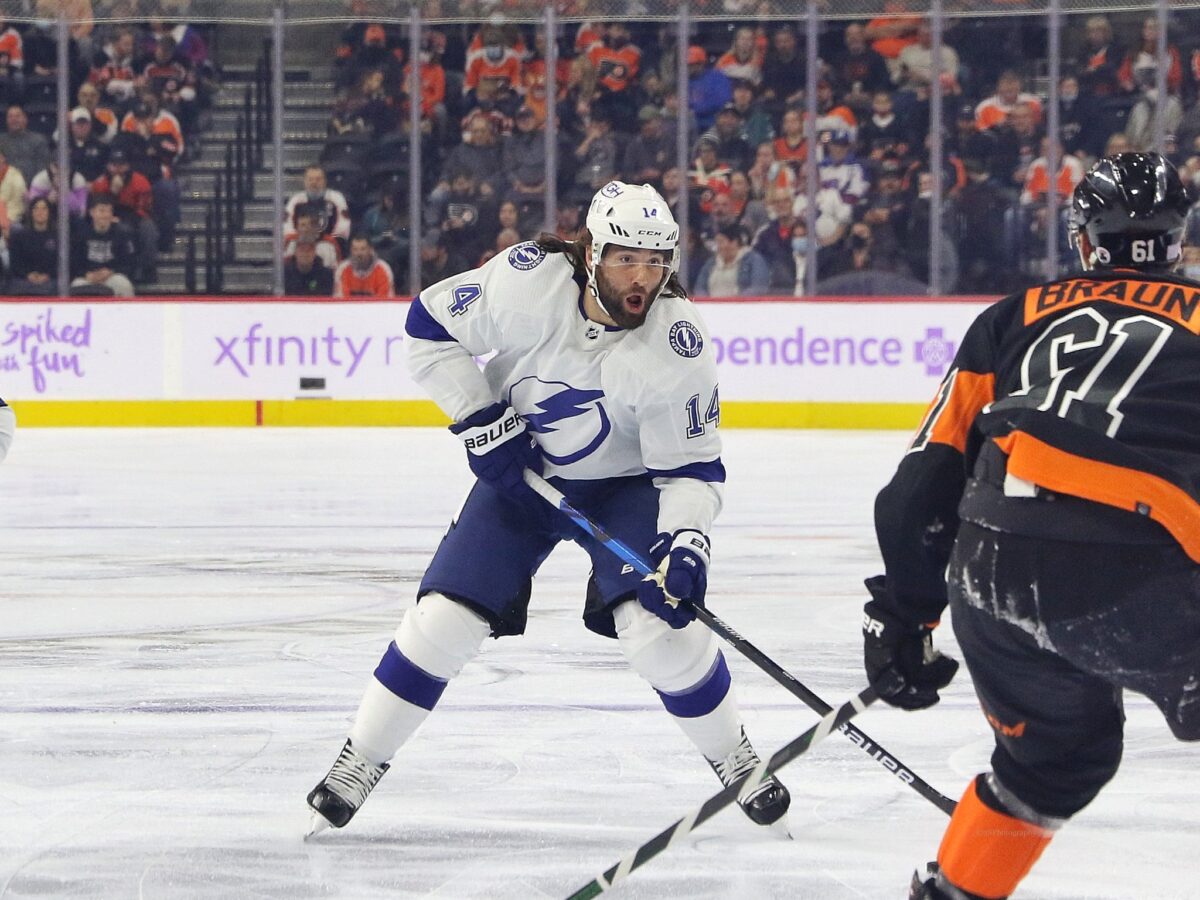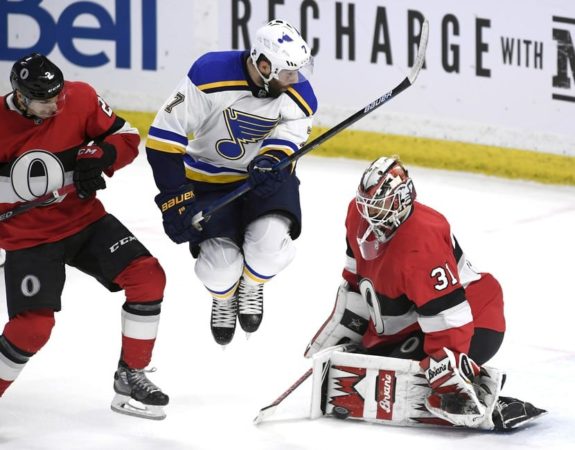The dream of any aspiring NHL’er is to one day hoist the Stanley Cup above your head. For many, this goal remains a dream, as even reaching the Cup Final is a feat of sports, let alone winning it all multiple times.
Yet, since the 2019 Playoffs, one player has become accustomed to holding the Stanley Cup. That is, of course, Pat Maroon, the tough-as-nails bottom-six forward who has become a fixture on championship-winning teams while carving his name into the history books.

As Maroon continues making history by attempting to win his fourth-straight Stanley Cup, let’s take a look back at the path that led him to this legendary status.
Maroon Overcame Self-Conflict to Reach the NHL
Born in St. Louis, Missouri, Maroon was drafted in the sixth round of the 2007 NHL Draft by the Philadelphia Flyers. As a big-bodied forward with solid offensive potential, there was definitely space in the league for a player with his skill set, but it was going to take some time.
Initially, Maroon played with the Flyers’ then America Hockey League (AHL) affiliate, the Adirondack Phantoms, where he flashed scoring potential. In his first two seasons, he posted at least 40 points, despite struggling with injuries.
Related: Oilers’ Former Goalie Koskinen Deserves Appreciation in Edmonton
Even with this solid start to his professional career, Maroon was seen to lack commitment to the sport by the Flyers organization. For example, he continued playing inline roller hockey in the offseason and even helped to lead the United States Men’s National Inline Roller Hockey Team to a Gold Medal at the 2010 IIHF InLine Hockey World Championship.
After arriving to the AHL in 2010, the team was unhappy with his conditioning, so he was released by the Phantoms, throwing his career into limbo.

It didn’t take long for Maroon to get another chance, however. On November 21st, 2010, he was traded along with David Laliberte to the Anaheim Ducks for Rob Bordson and Danny Syvret. With this new opportunity, he quickly made his mark with the then Ducks AHL affiliate, the Syracuse Crunch. He posted 21 goals and 48 points along with 68 penalty minutes in his first season and followed that up with a 32-goal, 74-point campaign in 2011-12 where he also added 120 penalty minutes to his stat line.
During this time, Maroon started earning call-ups to play with Anaheim, and he eventually took over a mostly full-time role with the team by 2013-14. While he was never an offensive dynamo, he still chipped in roughly 10 goals and 20-plus points each season, while finding a perfect bottom-six role for his gameplan.
Maroon Was Traded Twice as Veteran Depth
Following two and a half successful seasons with the Ducks, Maroon was dealt to the Edmonton Oilers near the 2016 Trade Deadline. With Edmonton, he really started to find his game, leading him to receive playing time alongside the likes of Connor McDavid. While the Oilers didn’t reach the postseason in 2016, they would take that step in 2016-17, with Maroon contributing 27 goals and 42 points throughout the regular season, along with eight points in the playoffs.
However, the good times would not last for Edmonton. After making a positive step forward, the franchise took a step back again in 2017-18. As an unrestricted free agent in the upcoming offseason, the Oilers decided to trade Maroon to the New Jersey Devils at the 2018 Deadline.
“I didn’t really want to get traded out of Edmonton,” Maroon said. “I actually loved it there. I actually liked it. The fans are great. I liked it. You know what the most important thing was? The guys were great. Unbelievable guys. You could not have found a better group of guys. But obviously I got traded for a reason. We weren’t winning.”
David Staples (From “It sucks”: Patrick Maroon on losing in hockey-mad Edmonton – Edmonton Journal, July 23, 2018)
While Maroon wasn’t thrilled by this decision, he still brought his best game to New Jersey, scoring 13 points in 17 games played, along with one postseason goal in five games. After the Devils were eliminated in Round 1 of the playoffs, he had an operation to fix a herniated disc in his back before becoming an unrestricted free agent in 2018.
Home Cooking Brought Maroon Back to St. Louis
As a free agent, Maroon didn’t receive a deluge of offers but got the one that he wanted most. This ended up being a one-year, $1.75 million contract with his hometown team, the St. Louis Blues. With the chance to return home and be close to his family, this contract was a perfect opportunity for the St. Louis Native.
Even though the Blues started 2018-19 cataclysmically, the team eventually turned things around. As they wrapped up the regular season back in a playoff position, Maroon scored 10 goals and 28 points while taking on roughly 14 minutes of ice time each night. Once again, he wasn’t a star, but he was a great bottom-six energy forward.

In the postseason, Maroon made his mark in Blues history. He acted as an emotional leader in the locker room, while chipping in key goals, most notably the Game 7 overtime winner to send St. Louis to the Western Conference Final.
In the Stanley Cup Final, the Blues dug deep and found a way to pull off a Game 7 victory against the Boston Bruins, clinching the Stanley Cup. This marked one of the greatest turnarounds in NHL history, with Maroon getting to live out one of his childhood dreams in the process.
Maroon Joins Lightning and Continues Winning
Following this incredible season, Maroon found himself as a free agent once again in 2019. During this time, he was pursued by the Lightning, at the request of head coach John Cooper, who coached him back in Juniors when he played for the North American Hockey League. For Tampa Bay, he was more than a nostalgia signing, as the team needed to add more size and toughness to their bottom-six in order to hopefully get over their postseason hump.
After many delays, the Lightning would go on to claim the 2020 Stanley Cup, with Maroon becoming just the third player in the post-expansion era to win consecutive Cups with different teams. While he only scored one goal during the playoffs, his leadership and experience was invaluable during the run, especially given the difficulties of playing in the bubble.

Following this success, the Lightning wasted no time signing Maroon to a two-year contract extension. Affectionately nicknamed “Big Rig,” he continued finding success in the shortened 2020-21 regular season. Despite his time on ice seeing slight reduction, he understood his role in Tampa Bay, and he played his part well.
Maroon became the ultimate postseason heel, getting under the skin of opponents while chipping in the occasional but timely goal. Eventually, the Lightning would go on to win the 2021 Stanley Cup, and Maroon entered the record books as one of the few players ever to win it all in three-straight seasons.
Maroon Has Become Part of Tampa Bay’s Sports Culture
As the Lightning look to become the next sports dynasty after making it to their third-straight Stanley Cup Final in 2022, it’s impossible to imagine them finding this level of success without Maroon. Sure, he may not be a superstar, but he is the sort of player that every team needs to win.
Even though he may have been born in St. Louis and helped to bring his hometown a Cup in 2019, for the rest of his life, Maroon will be considered a legend of Tampa Bay sports. In many ways he has embodied everything right about the Lightning during their dominant postseason stretch over the last five years.
Related: 2022 NHL Draft Guide
Sure, he isn’t perfect, but much like the Lightning after 2019, he never quit, never backed down from the challenge, and never gave up when the odds were against him. When he reached the low point in his career, he found a way to grow and improve, instead of collapsing under the weight of the moment. He’s a truly special hockey player, and one that the sport is lucky to have.
Now, the question is: how long can Maroon continue this incredible run?